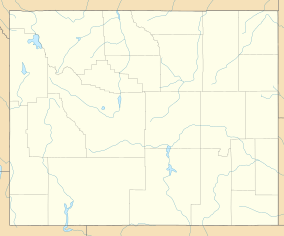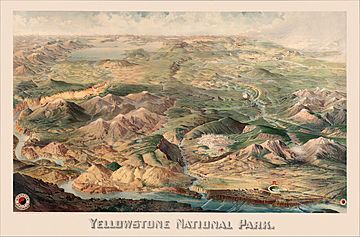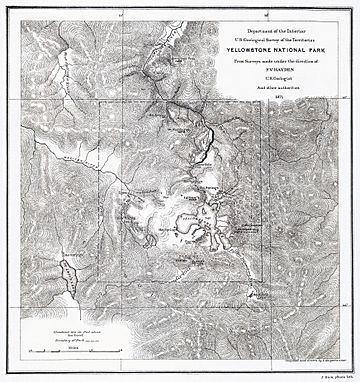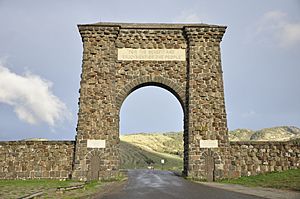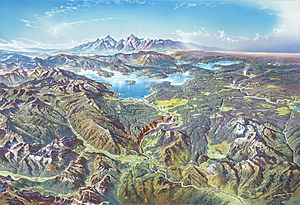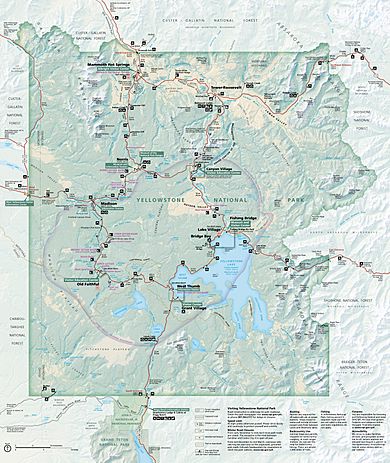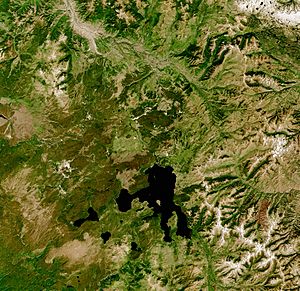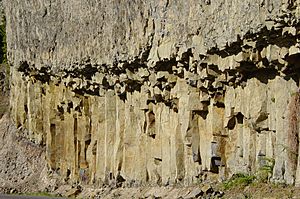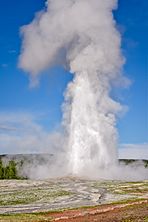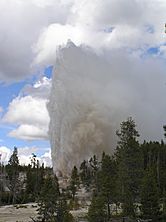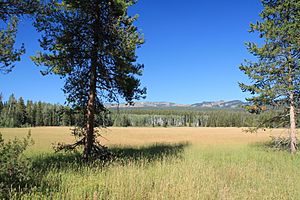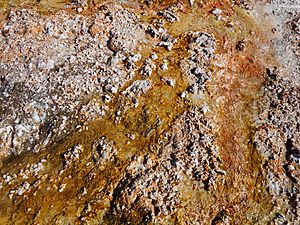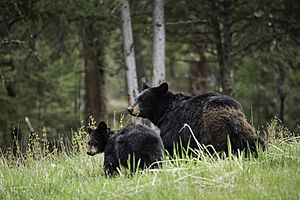Yellowstone National Park facts for kids
Quick facts for kids Yellowstone National Park |
|
|---|---|
|
IUCN Category II (National Park)
|
|
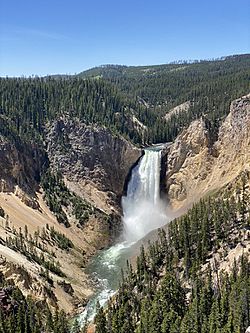
|
|
| Location | |
| Nearest town | West Yellowstone, Montana |
| Area | 2,219,791 acres (8,983.18 km2) |
| Elevation | 8,104 ft (2,470 m) |
| Established | March 1, 1872 |
| Visitors | 3,290,242 (in 2022) |
| Governing body | U.S. National Park Service |
| Type: | Natural |
| Criteria: | vii, viii, ix, x |
| Designated: | 1978 (2nd session) |
| Reference #: | 28 |
| Region: | The Americas |
| Endangered: | 1995–2003 |
Yellowstone National Park is a huge national park in the western United States. Most of it is in Wyoming, but parts also reach into Montana and Idaho. It was created on March 1, 1872, by President Ulysses S. Grant. Yellowstone was the very first national park in the U.S., and many people believe it was the first in the world!
The park is famous for its amazing wildlife and its many geothermal features. These include bubbling hot springs and spouting geysers. The most famous one is Old Faithful, which shoots water high into the air. Yellowstone has many different types of natural areas, but most of it is covered in subalpine forests.
Native Americans lived in the Yellowstone area for at least 11,000 years. Later, in the 1800s, explorers and fur trappers visited. But organized trips to explore the area didn't start until the late 1860s. At first, the U.S. Department of the Interior managed the park. Then, the U.S. Army took over for 30 years, from 1886 to 1916. In 1917, the park's management moved to the National Park Service, which had just been created.
Yellowstone National Park covers a huge area of 3,468.4 sq mi (8,983 km2). It has lakes, deep canyons, rivers, and tall mountain ranges. Yellowstone Lake is one of the largest high-up lakes in North America. It sits over the Yellowstone Caldera, which is the biggest supervolcano on the continent. This volcano is currently sleeping, but it has erupted with huge power many times in the past. More than half of the world's geysers and hot springs are in Yellowstone. They are all powered by this underground volcano. In 1978, Yellowstone was named a UNESCO World Heritage Site.
The park is home to hundreds of kinds of mammals, birds, fish, reptiles, and amphibians. Some of these animals are endangered or threatened. The vast forests and grasslands also have unique plants. Yellowstone is known for its large animals, called megafauna. You can find grizzly bears, cougars, wolves, and large groups of bison and elk here. The Yellowstone Park bison herd is the oldest and largest public bison herd in the U.S.
Forest fires happen in the park every year. In 1988, very large fires burned almost one-third of the park. Yellowstone offers many fun activities like hiking, camping, boating, fishing, and sightseeing. Paved roads let you easily reach the main hot spring areas, lakes, and waterfalls. In winter, visitors often explore the park on guided tours using snow coaches or snowmobiles.
Contents
Park History
The park gets its name from the Yellowstone River. Near the end of the 1700s, French fur trappers called the river Roche Jaune, meaning "Yellow Stone." Later, American trappers used the English name. People often think the river was named for the yellow rocks in the Grand Canyon of the Yellowstone. But the real reason for the Native American name is not fully clear.
People have lived in the Yellowstone area for at least 11,000 years. These early Native Americans, from the Clovis culture, used the park's obsidian (a type of volcanic glass) to make tools and weapons. Arrowheads made from Yellowstone obsidian have been found far away, even in the Mississippi Valley. This shows that tribes traded obsidian over long distances.
In 1806, John Colter, an explorer, traveled through what would become the park. He saw hot springs and geysers. When he described a place of "fire and brimstone," most people didn't believe him. They called it "Colter's Hell." For the next 40 years, trappers reported seeing boiling mud and steaming rivers. But these stories were often thought to be myths.
In 1859, Captain William F. Raynolds led a survey of the Rocky Mountains. His group, which included geologist Ferdinand Vandeveer Hayden and guide Jim Bridger, tried to cross into the Yellowstone region. But heavy snow stopped them. The American Civil War then delayed more explorations until the late 1860s.
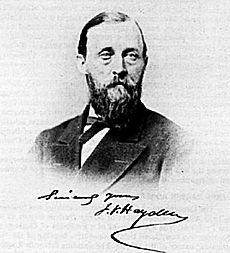
The first detailed trip to Yellowstone was in 1869 by three private explorers. They wrote a journal about what they saw. Based on their report, another group, the Washburn-Langford-Doane Expedition, explored the area in 1870. This group included Nathaniel P. Langford and a U.S. Army team. They spent about a month exploring and naming places.
A writer named Cornelius Hedges, who was on the Washburn expedition, suggested that the area should be protected as a national park. He wrote articles about his ideas. Others also thought the region should be saved.
How Yellowstone Became a Park
In 1871, Ferdinand V. Hayden finally explored the Yellowstone region. He led a large expedition with government support. His team took many photographs and made paintings. Their detailed report helped convince the U.S. Congress to protect this special area.
On March 1, 1872, President Ulysses S. Grant signed a law called The Act of Dedication. This law officially created Yellowstone National Park. Hayden strongly believed the area should be a "pleasure ground for the benefit and enjoyment of the people." He worried that people would try to make money from its natural wonders. He wanted the park to be "as free as the air or Water."
The law stated that the land was "reserved and withdrawn from settlement, occupancy, or sale." It was "dedicated and set apart as a public park or pleasuring ground for the benefit and enjoyment of the people." This meant no one could build or live there, except as allowed by the park.
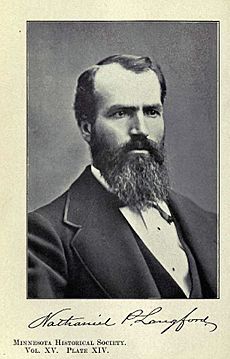
At first, some local people didn't like the park. They worried that strict rules would stop businesses like mining and logging. They wanted to make the park smaller. But Congress kept the park protected.
Nathaniel Langford became the park's first superintendent in 1872. He worked for five years without a salary, funding, or staff. This made it hard to protect the park from poachers and vandals. Langford knew Yellowstone would become a major attraction. He asked for a federal agency to protect it, but Congress said no at first.
In 1875, Colonel William Ludlow led an expedition to Yellowstone. His report showed how lawless the park was and how its resources were being taken. George Bird Grinnell, a naturalist on the trip, wrote about the poaching of bison, deer, and elk for their hides. He estimated that over 3,000 bison were killed in one winter.
Because of these problems, Langford had to step down in 1877. Philetus Norris took over as superintendent. Congress finally gave him a salary and some money to run the park. Norris used these funds to build roads and facilities. In 1880, Harry Yount was hired as the first gamekeeper to stop poaching. He is considered the first national park ranger. But these efforts were still not enough.

Native American tribes were mostly kept out of the park in the 1870s and 1880s. Some tribes, like the Sheepeaters, had used the area seasonally. A treaty in 1868 allowed them to hunt in Yellowstone, but the U.S. never approved it. In 1877, about 750 Nez Perce people passed through the park while being chased by the U.S. Army. Some visitors were taken captive, and a few people were killed. A stream in the park was named Nez Perce Creek to remember their journey.

The Northern Pacific Railroad built a train station in Livingston, Montana, in 1883. This helped more people visit the park. The number of visitors grew from 300 in 1872 to 5,000 in 1883. Train lines were extended closer to the park entrances over time. However, visitors faced dusty roads and limited services. Cars were first allowed in the park in 1915.
Poaching and damage to nature continued until the U.S. Army arrived in 1886. They built Camp Sheridan, which later became Fort Yellowstone. The army created rules to protect wildlife and natural resources while allowing public access. When the National Park Service was created in 1916, it adopted many of the army's rules. The army handed control to the National Park Service on October 31, 1918.
Park Development and Changes
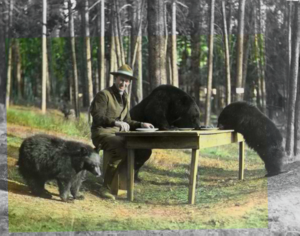
By 1915, 1,000 cars were entering the park each year. This caused problems with horses and horse-drawn wagons. Eventually, horse travel on roads was stopped.
From 1933 to 1942, the Civilian Conservation Corps (CCC) helped build many facilities in Yellowstone. They planted trees, built campgrounds and trails, and helped with fire prevention. The CCC built most of the early visitor centers and roads.
During World War II, fewer tourists visited, and park staff was cut. Many facilities became run down. In the 1950s, park visits greatly increased. To handle more visitors, park officials started "Mission 66." This plan aimed to modernize and expand park facilities by 1966. Later, new buildings went back to the traditional log cabin style.
The 1959 Hebgen Lake earthquake just west of Yellowstone damaged roads and buildings. New geysers appeared, and some hot springs became muddy. This was the strongest earthquake in the region's recorded history.
In 1963, there was a debate about reducing the elk population. The Secretary of the Interior asked scientists to study how to manage wildlife in national parks. Their report suggested that killing animals was not effective.
The wildfires of 1988 were the largest in the park's history. About 36% of the park burned. This led to new ways of managing fires. The fire season was normal until a drought and heat in mid-July made the fire danger extreme. On August 20, 1988, strong winds caused the fires to spread very quickly.
In October 2013, Yellowstone National Park closed due to a U.S. government shutdown.
Research and Recognition
Over 1,000 archeological sites have been found in Yellowstone, showing its long human history. The park has 1,106 historic structures and features. Some of these, like Obsidian Cliff, are special National Historic Landmarks. Yellowstone was named an International Biosphere Reserve in 1976 and a UN World Heritage Site in 1978. It was on the List of World Heritage in Danger from 1995 to 2003 because of tourism, wildlife diseases, and invasive species.
The Heritage and Research Center is in Gardiner, Montana, near the park's north entrance. It holds Yellowstone's museum collection, historical records, and a research library. The archives have records from the park's management and major projects.
Park Geography
About 96% of Yellowstone National Park is in Wyoming. Three percent is in Montana, and one percent is in Idaho. The park is 63 miles (101 km) long from north to south and 54 miles (87 km) wide from west to east. Yellowstone covers 2,219,789 acres (8,983 km2; 3,468 sq mi), which is larger than the states of Rhode Island or Delaware.
Lakes and rivers cover five percent of the park. The largest lake is Yellowstone Lake, which is 87,040 acres (352 km2; 136 sq mi) big. It is up to 400 feet (120 m) deep and has 110 miles (180 km) of shoreline. At 7,733 feet (2,357 m) above sea level, Yellowstone Lake is the largest high-elevation lake in North America. Forests cover 80% of the park, and most of the rest is grassland.
The Continental Divide of North America runs through the park. This line separates waters that flow to the Pacific Ocean from those that flow to the Atlantic Ocean. About one-third of the park is on the west side of this divide. The Yellowstone River flows to the Gulf of Mexico, while the Snake River flows to the Pacific Ocean.
The park sits on the Yellowstone Plateau, which is about 8,000 feet (2,400 m) above sea level. Mountains surround the plateau, reaching 9,000 to 11,000 feet (2,700 to 3,400 m) high. The highest point in the park is Eagle Peak (11,358 feet (3,462 m)). The most famous mountain on the plateau is Mount Washburn at 10,243 feet (3,122 m).
Yellowstone National Park has one of the world's largest petrified forests. These are trees that were buried by ash and soil long ago and turned into stone. The ash came from the park's supervolcano. The park also has 290 waterfalls that are at least 15 feet (4.6 m) tall. The highest is the Lower Falls of the Yellowstone River at 308 feet (94 m).
Three deep canyons are in the park. The Lewis River flows through Lewis Canyon. The Yellowstone River has carved two colorful canyons: the Grand Canyon of the Yellowstone and the Black Canyon of the Yellowstone.
Park Geology
Volcanoes and Hotspots
Yellowstone is at the end of the Snake River Plain, a curve through the mountains that stretches about 400 miles (640 km) from the park. Yellowstone's volcanoes are connected to older volcanoes in the Snake River Plain. Yellowstone is an active part of a hotspot that has moved northeast over time.
The Yellowstone Caldera is the biggest volcanic system in North America. It's called a "supervolcano" because it was formed by huge, explosive eruptions. The magma chamber under Yellowstone is about 37 miles (60 km) long, 18 miles (29 km) wide, and 3 to 7 miles (4.8 to 11.3 km) deep.
The current caldera was formed by a giant eruption 640,000 years ago. This eruption was more than 1,000 times bigger than the 1980 eruption of Mount St. Helens. It created a caldera nearly 1 kilometer deep and 45 by 28 miles (72 by 45 km) wide. The most powerful known eruption happened 2.1 million years ago. A smaller eruption happened 1.3 million years ago.
Each of these three huge eruptions sent out massive amounts of ash. This ash covered much of central North America. The ash and gases likely changed world weather patterns and caused some animal species to die out.
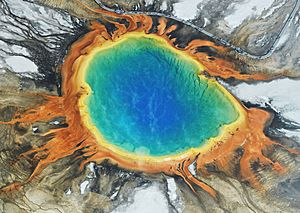
Another caldera-forming eruption happened about 160,000 years ago. It formed the smaller caldera that holds the West Thumb of Yellowstone Lake. Since the last super-eruption, many smaller eruptions have filled the Yellowstone Caldera with lava. You can see these lava flows at the Grand Canyon of the Yellowstone, where the river cuts through them.
Geysers and Hot Springs
The most famous geyser in the park is Old Faithful. It's in the Upper Geyser Basin. Other geysers in this area include Castle Geyser, Lion Geyser, and Grand Geyser. The park also has the tallest active geyser in the world, Steamboat Geyser, in the Norris Geyser Basin.
A study in 2011 found that at least 1,283 geysers have erupted in Yellowstone. On average, 465 of them are active each year. Yellowstone has at least 10,000 geothermal features in total. These include geysers, hot springs, mudpots, and fumaroles (steam vents). More than half of the world's geysers and hot springs are in Yellowstone.
In 2001, the U.S. Geological Survey, Yellowstone National Park, and the University of Utah created the Yellowstone Volcano Observatory (YVO). This group watches the park's geology and shares information about potential dangers.
In 2003, changes at the Norris Geyser Basin caused some trails to close. New steam vents appeared, and some geysers became more active and hotter. This showed how active Yellowstone's underground system is. Experts say there is no increased risk of a volcanic eruption soon.
Earthquakes in Yellowstone
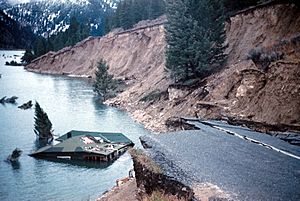
Yellowstone has thousands of small earthquakes every year. Most of them are too small for people to feel. About two-thirds of these earthquakes happen between Hebgen Lake and the Yellowstone Caldera.
There have been six earthquakes with a magnitude of 6 or higher in recorded history. The 7.2-magnitude 1959 Hebgen Lake earthquake happened just outside the park in 1959. This quake caused a huge landslide and created a new lake called Quake Lake. Twenty-eight people died, and there was a lot of damage. The earthquake also made some geysers erupt and caused cracks in the ground.
A 6.1-magnitude earthquake hit inside the park in 1975, but it caused little damage. In 1985, 3,000 small earthquakes happened over three months. This is called an earthquake swarm. These swarms are common in Yellowstone. In December 2008, over 250 earthquakes were measured under Yellowstone Lake. In January 2010, more than 250 earthquakes were detected in two days.
On March 30, 2014, a 4.8-magnitude earthquake struck near the Norris Basin. It was the largest earthquake in the park since 1980, but no damage was reported.
Park Biology and Ecology
Yellowstone National Park is the center of the 20 million acres (80,940 km2; 31,250 sq mi) Greater Yellowstone Ecosystem. This area includes Grand Teton National Park and other protected lands. It is the largest nearly untouched natural area in the lower 48 U.S. states. Thanks to the successful wolf reintroduction program in the 1990s, most of the original plants and animals that lived here long ago can still be found.
Yellowstone Plants (Flora)
Over 6,900 types of trees and other plants are native to the park. Another 170 types are non-native. Lodgepole Pine forests cover 80% of the park's forested areas. Other trees include Subalpine Fir and Engelmann Spruce. Quaking Aspen and willows are common deciduous trees. Aspen forests had declined but are now recovering. Scientists think this is because wolves were brought back, which changed how elk graze.

Many kinds of flowering plants grow in Yellowstone, mostly blooming from May to September. The Yellowstone sand verbena is a rare flowering plant found only in Yellowstone. It lives in the sandy soils along Yellowstone Lake.
In Yellowstone's hot waters, tiny living things called bacteria form colorful mats. These bacteria are very old forms of life. Scientists have found that some of these bacteria get their food from molecular hydrogen.
A special bacterium called Thermus aquaticus was found in Yellowstone's hot springs. It produces an important enzyme (Taq polymerase) used to copy DNA in labs. This is very helpful for scientific research. Other bacteria in Yellowstone's hot springs might also help scientists find cures for diseases.
Non-native plants can sometimes harm native species by taking their nutrients. These plants are often found near roads and tourist areas. Park staff work to remove them, but it takes a lot of time and money.
Yellowstone Animals (Fauna)
Yellowstone is considered one of the best places to see large animals, or megafauna, in the lower 48 states. There are almost 60 kinds of mammals in the park. These include Rocky Mountain wolf, coyote, Canadian lynx, cougars, and black and grizzly bears. Other large mammals are bison, elk, moose, mule deer, and bighorn sheep.
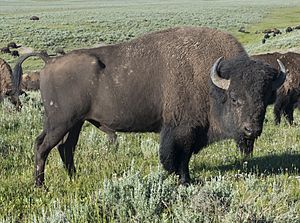
The Yellowstone Park bison herd is the largest public bison herd in the U.S. Bison numbers grew from less than 50 in 1902 to 4,000 by 2003. In 2005, the herd reached a peak of 4,900 animals. Yellowstone's bison herd is one of only four wild and pure herds in North America.
Ranchers worry that bison can spread diseases like brucellosis to their cattle. About half of Yellowstone's bison have been exposed to brucellosis. This disease can cause cattle to miscarry. But there have been no reported cases of bison spreading it to cattle. Elk also carry the disease.
To prevent disease spread, park staff often guide bison back into the park if they wander out. In the winter of 1996–1997, over 1,000 bison that left the park were killed or sent to slaughter. Animal rights groups say this is cruel. Ecologists point out that bison are just going to their natural grazing areas.

In 1914, the U.S. Congress provided money to kill wolves and other animals that were thought to harm farming. By 1926, park hunters had killed 136 wolves. Wolves were almost completely removed from Yellowstone. This continued until 1935. After wolves were gone, coyotes became the main predator. But coyotes can't hunt large animals. This led to more sick and weak large animals.
By the 1990s, the government changed its mind about wolves. In a debated decision, U.S. Fish and Wildlife Service brought northwestern wolves from Canada back into the park. This reintroduction has been successful. In 2005, there were 13 wolf packs with 118 wolves in Yellowstone. Most of these wolves came from the 66 wolves brought back in 1995–96. The wolf population has grown so much that they were removed from the endangered species list in 2008. As of January 2023, there are at least 108 wolves in 10 packs in the park.
Black bears are common in the park. In the early 1900s, visitors were allowed to feed them. This led to many injuries. Since the 1960s, feeding bears and getting too close is not allowed. This has greatly reduced injuries. Yellowstone is one of the few places where black bears and grizzly bears live together.
As of 2017, about 700 grizzly bears lived in the Greater Yellowstone Ecosystem. About 150 of them lived in Yellowstone National Park. Grizzly bears were listed as a threatened species in 1975. They were removed from the list in 2007 and again in 2017. But in 2018, a judge ruled that their protections must be put back. Hunting is not allowed in Yellowstone National Park.
More than 30,000 elk live in Yellowstone. This is the largest population of any large mammal in the park. The northern elk herd has decreased since the mid-1990s. This is partly due to wolves hunting them. The northern herd moves into Montana in winter. The southern herd moves south to the National Elk Refuge. This is the largest mammal migration in the U.S. outside of Alaska.
Other less common mammals include the mountain lion and wolverine. There are only about 25 mountain lions in the park. The number of wolverines is not known. These rare animals help scientists understand the health of protected lands like Yellowstone.
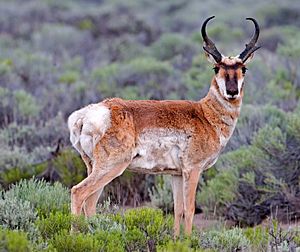
Eighteen kinds of fish live in Yellowstone. This includes the Yellowstone cutthroat trout, which is popular with anglers. The cutthroat trout has faced threats from lake trout, an invasive species that eats them. Lake trout were illegally introduced into Yellowstone Lake. The cutthroat trout has also faced drought and a disease called whirling disease. Since 2001, all native sport fish caught in Yellowstone must be released.
Yellowstone is also home to seven kinds of reptiles. These include the painted turtle and prairie rattlesnake. There are also four kinds of amphibians, such as the boreal chorus frog and tiger salamander.
Three hundred eleven kinds of birds have been seen in Yellowstone. Almost half of them nest in the park. In 1999, 26 pairs of nesting bald eagles were found. Very rare sightings of whooping cranes have been recorded. Other rare birds in Yellowstone include the common loon and trumpeter swan.
Climate and Weather
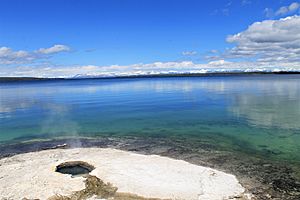
Yellowstone's climate changes a lot with altitude. Lower areas are generally warmer. The highest temperature recorded was 99 °F (37 °C) in 2002. The coldest was −66 °F (−54 °C) in 1933. In summer (June to early September), daytime highs are usually 70 to 80 °F (21 to 27 °C). Nights can drop below freezing, especially in higher areas. Summer afternoons often have thunderstorms.
Spring and fall temperatures are between 30 and 60 °F (−1 and 16 °C). Nights can be very cold, from −5 to −20 °C. Winter in Yellowstone usually has high temperatures between 0 and 20 °F (−18 and −7 °C). Nighttime temperatures are often below 0 °F (−18 °C).
Rain and snow vary greatly across the park. Some areas get 15 inches (380 mm) of rain each year, while others get 80 inches (2,000 mm). Snow can fall in any month, but it's most common from November to April. Yellowstone Lake gets about 150 inches (3,800 mm) of snow annually. Higher elevations get twice that amount.
Tornadoes are rare in Yellowstone. However, on July 21, 1987, the strongest tornado ever recorded in Wyoming hit the park. It was an F4 tornado, with winds up to 260 miles per hour (420 km/h). It destroyed 15,000 acres (6,100 ha; 23 sq mi) of pine forest.
In June 2022, the park closed its entrances and evacuated visitors. This was due to record rainfall and flooding. Roads and bridges were washed out, and there were power outages and mudslides. The Yellowstone River reached a new record height. The park partly reopened on June 22 after being closed for nine days. The north entrance opened on October 30, and the northeast entrance opened on October 15.
Recreation and Activities
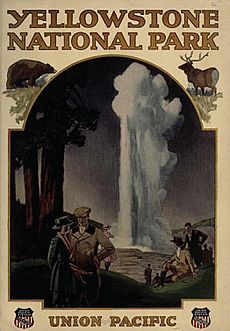
Yellowstone is one of the most popular national parks in the United States. Since the mid-1960s, at least 2 million tourists have visited almost every year. From 2007 to 2016, the average was 3.5 million visitors annually. In 2016, a record 4,257,177 people visited. July is the busiest month.
During peak summer, about 3,700 people work for park businesses. These businesses manage nine hotels and lodges with over 2,200 rooms. They also run gas stations, stores, and most campgrounds. Another 800 people work for the National Park Service.
Park roads lead to the main attractions. However, road repairs can cause temporary closures. Yellowstone is always working on road improvements, but the repair season is short. In winter, most roads are closed to cars. They are closed from early November to mid-April, and some stay closed until mid-May. The park has 310 miles (500 km) of paved roads. You can enter from five different entrances.
There is no public transportation inside the park. But you can find tour companies that offer guided trips. In winter, these companies offer guided snowmobile and snow coach tours. The Old Faithful, Canyon, and Mammoth Hot Springs areas are very busy in summer. Traffic jams can happen when people stop to watch wildlife.
The National Park Service runs nine visitor centers and museums. They also maintain historical buildings. These include the Old Faithful Inn, built in 1903–1904, and the Fort Yellowstone – Mammoth Hot Springs Historic District. You can take a historical tour at Fort Yellowstone to learn about the park's history.
Camping is available at a dozen campgrounds with over 2,000 campsites. You can also camp in nearby National Forests and Grand Teton National Park. Backcountry campsites are only reached by walking or riding a horse and require a permit. There are 1,100 miles (1,800 km) of hiking trails. Yellowstone is not great for mountain climbing because the volcanic rock is unstable.
Visitors with pets must keep them on a leash. Pets are only allowed near roads and in certain "front country" areas like drive-in campgrounds. Around hot springs, there are wooden and paved trails to keep visitors safe. Most of these areas are accessible for people with disabilities. The National Park Service has a clinic at Mammoth Hot Springs and offers emergency services all year.
Hunting is not allowed in the park. But it is allowed in the surrounding national forests during hunting season. Fishing is popular, and you need a Yellowstone Park fishing license. Many park waters are for fly fishing only. All native fish caught must be released. Boating is not allowed on rivers and creeks, except for a 5 miles (8.0 km) stretch of the Lewis River. This section is only for non-motorized boats. Yellowstone Lake has a marina, and Lewis Lake has a boat ramp.
In the early days of the park, visitors were allowed to feed the bears. People liked taking pictures with the bears, who had learned to beg for food. This led to many human injuries each year. In 1970, park officials changed this rule. They started teaching people about the dangers of getting close to bears. They also worked to stop bears from finding food in campgrounds. Now, it's harder to see bears up close, but the number of injuries and deaths has dropped a lot.
Other protected lands nearby include Caribou-Targhee, Gallatin, Custer, Shoshone, and Bridger-Teton National Forests. The John D. Rockefeller, Jr. Memorial Parkway is to the south and leads to Grand Teton National Park. The famous Beartooth Highway offers amazing high-altitude views from the northeast.
Nearby towns include West Yellowstone, Montana; Cody, Wyoming; Red Lodge, Montana; Ashton, Idaho; and Gardiner, Montana. The closest airports are in Bozeman, Montana; Billings, Montana; Jackson; Cody, Wyoming, or Idaho Falls, Idaho. Salt Lake City, 320 miles (510 km) to the south, is the closest large city.
Images for kids
-
Thomas Moran painted Tower Creek during the Hayden Geological Survey of 1871.
-
Old Faithful erupts approximately every 90 minutes.
-
Steamboat Geyser is the world's largest active geyser.
See also
 In Spanish: Parque nacional de Yellowstone para niños
In Spanish: Parque nacional de Yellowstone para niños


